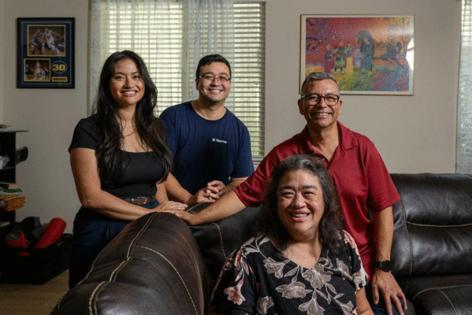Flipping tortillas with chopsticks: California Asian-Latino families create their own culture
Published in Dating Advice
SACRAMENTO, Calif. -- Traces of Mexican and Chinese cultures are evident in every corner of the Salinas’ family Woodland, California, home.
In the living room, Chinese history books, paintings and dolls share space with family photos and high school diplomas. The family calls this area the “Chinese room,” said Jesse, a first-generation Mexican-American.
There, his wife Lisa, a fifth-generation Chinese-American, entertained her youngest grandchild with toy dogs. “Mira los perritos,” she said in Spanish to the 1-year-old.
A few feet away, in the “Mexican room,” a photo of the civil rights leader Cesar Chavez hangs proudly on the wall while a bookcase displays copies of the Spanish novel Don Quixote.
Here, the Salinas’ adult children Felicia and Esteban reminisced about their childhood.
The two siblings spent Christmas Eve making tamales and Christmas Day enjoying dim sum. They learned Spanish fluently from their parents and in a dual-language program. Meanwhile, they spent Friday evenings at Chinese school.
Esteban called himself “ChiMex.” Felicia mastered flipping tortillas with chopsticks.
“I felt like I was a chameleon in many ways, where I had the ability to speak to my audience and whatever community I was with,” Felicia, 32, said.
That effortless blend, however, does not happen overnight. In this case, it was a yearslong, deliberate effort by two parents who wanted to ensure their three children learned the complexities of both cultures and felt confident in their dual identities.
“We had discussions that people are going to question our children,” said Lisa Yep Salinas, their Chinese-American mother. “Are you really Mexican? Or are you really Chinese? That meant we needed to train them in a way that, without a doubt, they feel that they are both, and this is their identity.”
Lisa and husband Jesse understood that their children fall into a small but growing demographic of people who identify as both Latino and Asian American or Pacific Islander.
The population of AAPI Latinos in the U.S. has more than doubled since 2000, according to a May report from the UCLA Latino Policy and Politics Institute. California is home to roughly 300,000 — the most out of any other state.
In Sacramento County alone, about 14,000 people identified as AAPI Latinos in 2022. This community is comprised of two sides of the region’s and state’s largest non-white groups and offers a snapshot of an increasingly multi-racial society.
But for those who belong to both groups, life can become a series of balancing acts. These individuals, nearly half of whom are under 18, often grapple with the complexities of two languages, cultures and identities. Some feel a need to gravitate toward one heritage over the other but can’t seem to grasp both.
Esteban’s struggles came early during his childhood and centered around his looks and predominately Spanish male name. At the same time, he had a more pale skin color and Asian features.
“Automatically, no one thought I belonged,” said Esteban, now 35. “So the Asians would see my name and say ‘You’re not one of us.’ And then Latinos, would see my name, but then they would see my face.”
‘Learn to understand’
The Salinas parents met nearly 40 years ago while attending the University of California, Santa Cruz.
Jesse was a sophomore studying psychology. Lisa was a freshman and eventual biology major. Both had grown up in different parts of the Bay Area and spent months as friends before dating.
The couple said they initially endured disapproval from Latino and Asian classmates who believed both should be dating someone of their own race. In the 1980s, when they began dating, it had been just more than a decade since interracial marriage was legalized across the nation. The share of intermarried newlyweds had only risen to 7%.
“There was definitely a push to discourage the relationship between us,” Jesse said.
But for them, at least initially, cultural identity was an afterthought.
Lisa said she didn’t realize Jesse was Mexican until six months into their relationship. Soon after, she met his mostly Spanish-speaking family and committed to learning the language to communicate with his mother. She spent the next few years taking Spanish-speaker classes and took a semester abroad in Costa Rica at the end of her college career. Jesse joined each step of the way to help her learn the language.
“I had to learn to understand her (Jesse’s mom) jokes,” Lisa said.
Jesse accommodated Lisa’s heritage in his own ways. Her grandfather playfully “tested him” in their first encounter. He evaluated Jesse’s chopsticks skills and ordered traditional Cantonese dishes like chicken feet and fish eyeballs.
“He wanted to see if he (Jesse) was strong enough to eat those things,” Lisa recalled.
At the Salinas wedding in 1989, a roasted pig at the center of the table separated the Mexican and Chinese cuisine. Jesse’s mother contributed a homemade piñata resembling a Quetzal — a colored bird that Lisa had studied in Costa Rica.
“That party was the epitome of our marriage and our relationship,” Jesse said.
Years later, as parents, the Salinas made it a point to incorporate both cultures into their children’s lives. The holidays provided those opportunities.
The festivities often began with the Day of the Dead in November and stretched until Chinese New Year in January or February. All the while, the family enjoyed a mixture of foods including tamales, dim sum, sopes, lap cheong and carne asada.
“It was always centered around family, having those conversations around food and enjoying each other’s company,” Felicia said.
‘Together in community’
AAPI Latinos have existed for centuries.
The first recorded history of the community began in the late 1500s, when Mexico and the Philippines were connected for about 250 years via the Manila Galleon, trade routes used by Spanish merchants, according to UCLA professor Robert Chao Romero. Roughly 100,000 Asians arrived to Mexico during that time.
Romero said migration patterns of the two groups continued for hundreds of years, usually tied to labor, colonization and anti-immigrant sentiments.
“Historically, both Asians, especially Chinese, and Mexicans were viewed as as immigrant labor, cheap labor,” said Romero, who is of Chinese and Mexican descent.
Per the UCLA study, AAPI Latinos fall into four different groups: Asian immigrants from Latin America; those born in the U.S. to AAPI and Latino parents; Filipinos who are perceived as ethnically ambiguous due to the Spanish colonial history and descendants of Puerto Rican laborers who married Native Hawaiians in the 1800s. Most AAPI Latinos identify with the first two categories.
“Asians and Latinos are very much kind of interwoven into that same history,” Romero said.
But not every AAPI Latino feels as much harmony between their cultures as the Salinas siblings.
Elena Santamaria’s father, who was born in Mexico, immigrated to work in fields in Arizona before starting a flower business in the Bay Area. Her mother fled Saigon with her family during the Vietnam War and came to the U.S. as a refugee, eventually settling in San Jose.
“She actually bought flowers for her mom on her way home from school, and that’s how my parents met,” Santamaria, 34, said.
As a young girl, Santamaria ate tacos stuffed with salsa and Vietnamese-style barbecue meat. She learned Spanish from her cousins and Vietnamese while attending the Buddhist temple on weekends.
Her Vietnamese and Mexican cultures share a “family-oriented” focus that manifests in the form of large families, Santamaria said. Her mother has seven siblings and her father has 10.
Despite points of common ground, it was sometimes difficult for Santamaria to reconcile her cultural identities, especially as a child.
“I think a lot of the multi-ethnic folks struggle with this in the sense of, like, you’re not Mexican enough for the Mexicans, you’re not Vietnamese enough for the Vietnamese, you’re not American enough for the Americans,” Santamaria said.
She felt her mother’s Vietnamese culture often played a more dominant role in her childhood — an imbalance in cultural socialization that many multi-racial children experience from their parents.
She also believes that her father may have downplayed his Mexican background while trying to make a living in the U.S. due to prejudices or other barriers he had experienced, leading her to grow up without much Mexican culture in the household. She may have missed out on a quinceañera, but she sees her knowledge of Spanish as her main tie to her Mexican side.
Coming to terms with the different sides of her identity is a work in progress. She feels frustrated when people try to put her “into boxes” in an effort to get to know her by asking her about her ethnicity.
“Now I say I’m Vietnamese and Mexican, and not to put that box around it, to try to break down that narrative,” Santamaria said. “You are not 50%. That’s DNA. You are not 50% culturally.”
‘An immense privilege’
For elected officials tasked with representing diverse communities, having dual cultural identities may serve as an additional strength.
Alberto Torrico, 55, who is Bolivian and Japanese, served as Senate Majority Leader during his tenure as a state representative.
Although the California legislature is growing more diverse, Torrico said he saw some AAPI Latino colleagues in the past choosing to join either the Asian and Pacific Islander or Latino legislative caucus, but not both.
“I think my generation before — they culturally sort of picked one and you stayed in your lane,” Torrico said.
Over the years, he has seen that pattern begin to shift.
“If you’re a person of color, there’s never been a better time for you to be here,” Torrico said. “I think it’s even more so for women of color — my daughter and others. The opportunities are tremendous.”
West Sacramento city councilwoman Quirina Orozco said her identities — as Filipina and Mexican, a mother and a prosecutor, among others — help inform her approach to public service.
Orozco, 49, grew up eating adobo and pancit and learning how to roll a tight lumpia in her Filipina mother’s household. Meanwhile, she marks herself as Latina on official documents in acknowledgment of her father’s Mexican background.
Her platform allows her to advocate for communities of color who haven’t always been represented in government, she said.
In light of the impostor syndrome she has faced in the past, feeling like she did not belong in a “world of leadership that doesn’t look like you,” she believes that communities seeing people of color in positions like hers is important.
“It’s an immense privilege to be able to lead knowing that I have all of these different perspectives,” Orozco said.
‘I always knew who I was’
Back at the Salinas home, the family enjoyed a lunch of dumplings and shrimp katsu tacos in the “Mexican room.”
The mix of foods resembled a normal meal back when the Salinas’ three children were growing up. From holidays to sporting events, the parents made sure their kids were exposed to foods from diverse cultures — even beyond their Mexican and Chinese heritages.
“We’d always watch World Cup and cook foods from the different countries that were playing,” Lisa said.
Moments like this are less frequent now. Felicia has since moved away to Sacramento and started her own family. The Salinas’ oldest son lives in Southern California with his two children.
Today, the siblings fondly remember family Thanksgivings in which stuffing was replaced by Chinese sticky rice. They remembered that, instead of just Santa Claus, the Three Wise Men — or Los Reyes Magos — took center stage during the winter holidays.
But most of all, they recalled all their parent’s efforts to ensure they felt comfortable with their identities.
“That was something that they really fought hard for — to not feel like we were different, “ Esteban said. “Or if we were different, it’s something to be proud of.”
Folk tales were retold with characters that resembled Esteban and his brother. Felicia’s books were colored in to match her skin pigmentation and darker hair color.
“Coming here to the house, I always knew who I was and that’s something I still hold very true to this day,” Felicia said.
©2024 The Sacramento Bee. Visit at sacbee.com. Distributed by Tribune Content Agency, LLC.




















Comments